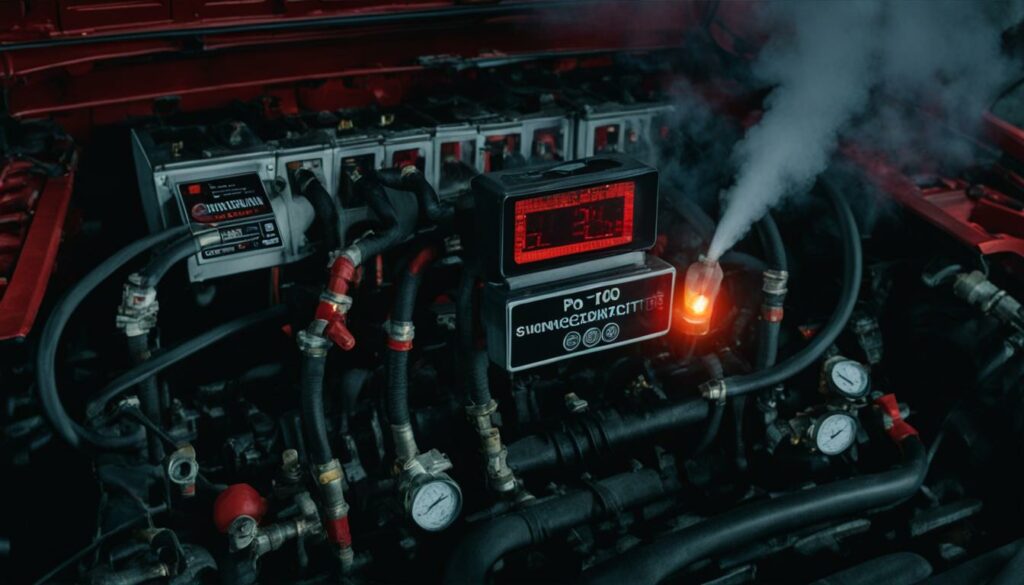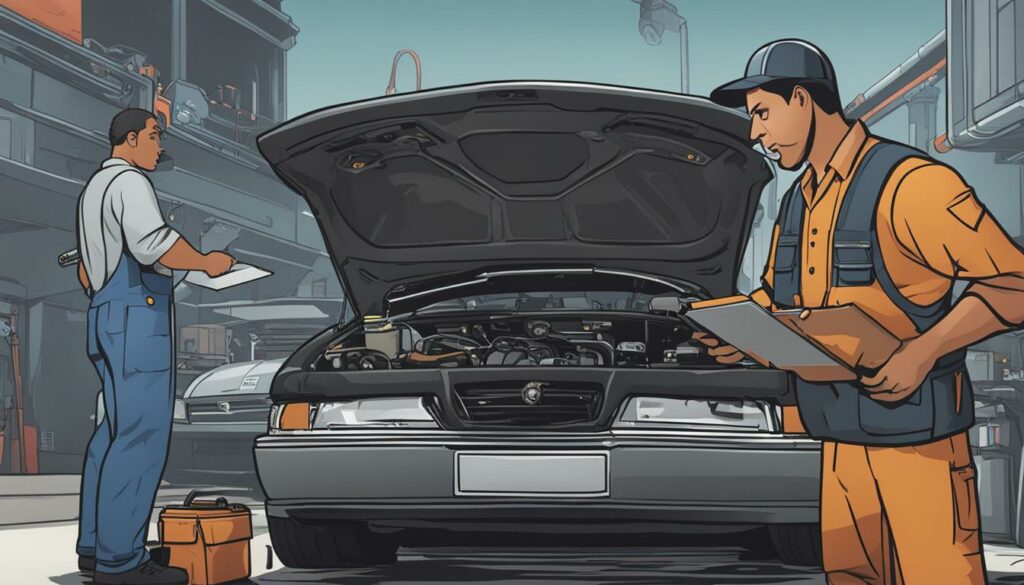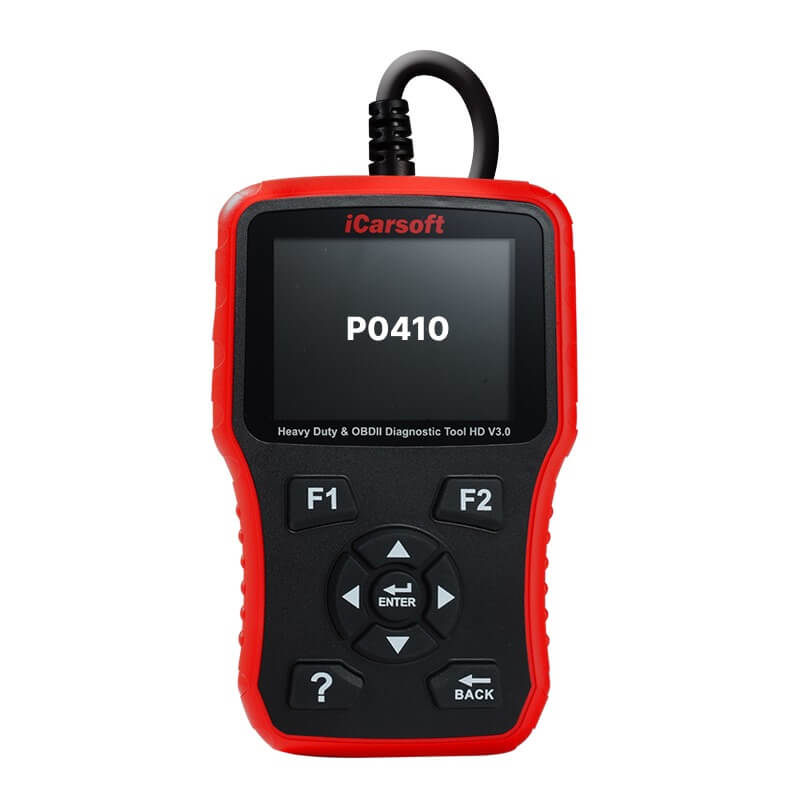P0410 – Secondary Air Injection System Malfunction
POSTED IN pcodes
Welcome to our article on the P0410 code, which relates to a malfunction in the secondary air injection system. This system plays a crucial role in reducing the emission of toxic gases into the atmosphere by injecting air into the exhaust stream during cold starts. Understanding the common symptoms, causes, troubleshooting steps, and repair solutions for this issue is essential for maintaining the performance and efficiency of your vehicle.
Diagnosing and resolving a P0410 code can be complex and requires expertise. It is recommended to seek the assistance of qualified technicians who have the necessary tools and knowledge to perform detailed tests and analysis. They will ensure accurate diagnosis and effective repairs, preventing any further damage to your vehicle.
Key Takeaways:
- The P0410 code indicates a malfunction in the secondary air injection system.
- Professional assistance from qualified technicians is essential for accurate diagnosis and repairs.
- Common symptoms include the check engine light illumination, rough idle, starting issues, and rattling noises.
- Common causes of the P0410 code include a faulty secondary air injection pump, clogged catalytic converter, and O2 sensor issues.
- Troubleshooting steps involve inspecting components, testing electrical connections, and identifying any air leaks or fuse issues.
Now that you have a brief overview of the P0410 code and its implications, let’s delve into the specific symptoms, causes, troubleshooting steps, and repair solutions to help you address this issue effectively.
Symptoms of P0410 – Secondary Air Injection System Malfunction
A P0410 code can manifest through various symptoms, indicating a malfunction in the secondary air injection system. It’s crucial to promptly address these symptoms to prevent further damage to your vehicle.
- Check Engine Light Illumination: One of the most common indications of a P0410 code is the illumination of the check engine light on your dashboard. This warning light serves as an early alert to potential issues.
- Rough Idle and Starting Issues: Another symptom that may arise from a P0410 code is a rough idle or difficulty starting the engine. You may experience unusual fluctuations in engine speed or prolonged cranking before the engine starts.
- Rattling Noises: If you hear rattling or abnormal noises coming from the engine bay, it could be a result of the secondary air injection system malfunctioning. These noises can indicate a problem with the air pump or other components of the system.
It’s important not to ignore these symptoms, as continued driving with a P0410 code can potentially lead to more severe damage and decrease your vehicle’s overall performance.
Buy tested tuning file for Adblue / EGR / DPF / Adblue off now!
Quote: “The check engine light is your vehicle’s way of communicating with you. Paying attention to these warning signs and taking prompt action can save you from more significant and expensive repairs down the road.” – John, experienced mechanic.
Having discussed the symptoms of a P0410 code, let’s now delve deeper into the common causes behind this secondary air injection system malfunction.
Common Causes of P0410 – Secondary Air Injection System Malfunction
When faced with a P0410 code, several common causes could be responsible for the secondary air injection system malfunction. Understanding these causes can help in diagnosing and resolving the issue effectively.
Failure of the Secondary Air Injection Pump
One possible cause of the P0410 code is the failure of the secondary air injection pump. This failure can be a result of moisture backflow into the pump, leading to corrosion or freezing. The pump plays a crucial role in injecting air into the exhaust stream during cold starts, and its malfunction can disrupt the proper functioning of the system.
Clogged Catalytic Converter
Another common cause of the P0410 code is a clogged catalytic converter. Carbon deposits from a rich air-fuel mixture can accumulate and block the catalytic converter, hindering the flow of exhaust gases. This blockage can affect the performance of the secondary air injection system, triggering the P0410 code.
O2 Sensor Issues
Issues with the O2 sensor can also contribute to the occurrence of the P0410 code. The O2 sensor monitors the oxygen levels in the exhaust gases and provides feedback to the engine control module. If the O2 sensor is faulty or not functioning optimally, it can send inaccurate readings, leading to the activation of the P0410 code.
Diagnosing the exact cause of the P0410 code requires meticulous testing and inspection by qualified technicians. They will utilize their expertise and specialized equipment to pinpoint the specific issue affecting the secondary air injection system.
Expert Insight: Understanding the common causes of the P0410 code can help in assessing the severity of the issue and planning appropriate repairs. It is recommended to seek professional assistance for a comprehensive diagnosis and efficient resolution.

| Common Causes | Description |
|---|---|
| Failure of the Secondary Air Injection Pump | Backflow of moisture into the pump causing corrosion or freezing |
| Clogged Catalytic Converter | Carbon deposits from a rich air-fuel mixture blocking the catalytic converter |
| O2 Sensor Issues | Faulty or suboptimal functioning of the O2 sensor |
Troubleshooting Steps for P0410 – Secondary Air Injection System Malfunction
Diagnosing a P0410 code can be done through several troubleshooting steps. By following these steps, you can identify and address the issues that may be causing the malfunction in the secondary air injection system. Here are the troubleshooting steps you can take:
- Use an OBD II reader to identify the trouble code and related codes. This will give you a starting point in understanding the specific issue with the system.
- Inspect the secondary air injection pump for any signs of damage, such as melting or rattling. Any visible damage to the pump may indicate the need for replacement.
- Identify air leaks in the hose system by using a vacuum tester or a smoke machine. These tools can help you detect any leaks that may be affecting the functionality of the system.
- Test the electrical components of the system using a multimeter. This will help you determine if there are any issues with the electrical connections or components.
- Inspect the downstream O2 sensor. A faulty O2 sensor can sometimes contribute to a P0410 code. Check for any signs of damage or malfunction.
- Check for any fuse issues. A blown fuse can prevent the secondary air injection system from functioning properly. Replace any blown fuses if necessary.
- Clean the secondary injection system. Over time, carbon buildup can occur and affect the system’s performance. Cleaning the system can help alleviate this issue.
By following these troubleshooting steps, you can diagnose and potentially resolve a P0410 code related to a malfunction in the secondary air injection system. However, it’s important to note that if you’re not comfortable or familiar with automotive repairs, it’s best to seek professional assistance. A qualified technician will have the expertise and equipment necessary to properly diagnose and repair the issue.

Repair Solutions for P0410 – Secondary Air Injection System Malfunction
If you’ve encountered a P0410 code indicating a malfunction in your vehicle’s secondary air injection system, there are several repair solutions available to resolve the issue. The appropriate solution will depend on the specific cause of the problem.
If the culprit is a faulty secondary air injection pump, replacing it may be necessary. This component is responsible for pumping air into the exhaust stream during cold starts, so a malfunction can significantly impact the system’s effectiveness.
In cases where a clogged catalytic converter is to blame, cleaning or replacing the converter may be the best course of action. Keeping the catalytic converter free from carbon deposits is crucial for optimal system performance.
Oxygen (O2) sensor issues can also trigger a P0410 code. If the sensor is malfunctioning, replacing it may be required to restore the system’s proper functioning.
Additionally, it’s important to inspect the system for any vacuum leaks or electrical problems. Fixing these issues can help ensure the air injection system operates as intended.
To determine the most appropriate repair solution for your specific case, we recommend consulting with a qualified technician. They have the expertise and knowledge to diagnose the problem accurately and provide tailored repair recommendations.
| Common Causes | Repair Solutions |
|---|---|
| Failed secondary air injection pump | Replace the pump |
| Clogged catalytic converter | Clean or replace the converter |
| O2 sensor malfunction | Replace the sensor |
| Vacuum leaks or electrical problems | Fix leaks or electrical issues |
Professional Assistance for P0410 – Secondary Air Injection System Malfunction
Sometimes, professional assistance may not be readily available or you may be exploring alternative solutions for the P0410 code. In such cases, one option to consider is the permanent removal of the code. This involves uploading the Engine Control Unit (ECU) file to a specific portal. However, it’s essential to note that this should only be considered as a last resort when professional assistance is unavailable and after understanding the potential consequences of permanent removal.
| Advantages of Professional Assistance | Disadvantages of Permanent Removal |
|---|---|
|
|
While seeking professional assistance offers several advantages in resolving the P0410 code, there may be instances where it’s not feasible or accessible. In such cases, cautious consideration should be given to the permanent removal of the code, taking into account the potential drawbacks and implications.
Conclusion
The P0410 code signifies a malfunction in the secondary air injection system. Ignoring this code can result in further damage to your vehicle and potential issues with emissions. To resolve this issue, it is important to understand the symptoms, common causes, and troubleshooting steps. Seeking professional assistance from qualified technicians is often the best course of action, as they have the necessary expertise and equipment to diagnose and repair the problem.
Understanding the technical description of the secondary air injection system and its meaning is crucial. The severity of this issue should not be underestimated, as it can impact the overall performance and efficiency of your vehicle.
Repairing the secondary air injection system failure may involve various solutions depending on the specific cause. This could include replacing the air injection pump, cleaning or replacing the catalytic converter, or addressing O2 sensor issues. It is important to consult with a qualified technician to determine the most appropriate repair solution for your vehicle.
In conclusion, addressing a P0410 code is essential to maintain the optimal functioning of your secondary air injection system. Understanding the technical aspects, severity of the issue, and available repair options will help you take the necessary steps to resolve this problem efficiently and effectively.
FAQ
What is a P0410 code?
A P0410 code is related to a malfunction in the secondary air injection system. This code indicates that there is an issue with the system that pumps air into the exhaust stream on cold starts to reduce emissions.
What are the symptoms of a P0410 code?
The most common symptom of a P0410 code is the illumination of the check engine light. Other symptoms include rough idle, starting issues, and rattling noises.
What are the common causes of a P0410 code?
Common causes of a P0410 code include a failure of the secondary air injection pump, a clogged catalytic converter, and O2 sensor issues.
What are the troubleshooting steps for a P0410 code?
Troubleshooting steps for a P0410 code include using an OBD II reader to identify the trouble code, inspecting the secondary air injection pump for damage, checking for air leaks in the hose system, testing electrical components with a multimeter, and inspecting the downstream O2 sensor.
What are the repair solutions for a P0410 code?
Repair solutions for a P0410 code can vary depending on the specific cause. They may include replacing the secondary air injection pump, cleaning or replacing the catalytic converter, replacing O2 sensors, fixing vacuum leaks, and addressing any electrical problems.
Should I seek professional assistance for a P0410 code?
Yes, it is recommended to seek professional assistance when dealing with a P0410 code. Qualified technicians have the experience and equipment to diagnose and repair the issue accurately.
What happens if the P0410 code is ignored?
Ignoring a P0410 code can lead to further damage to the vehicle and potential issues with emissions. It is essential to address the issue promptly to prevent further problems.


